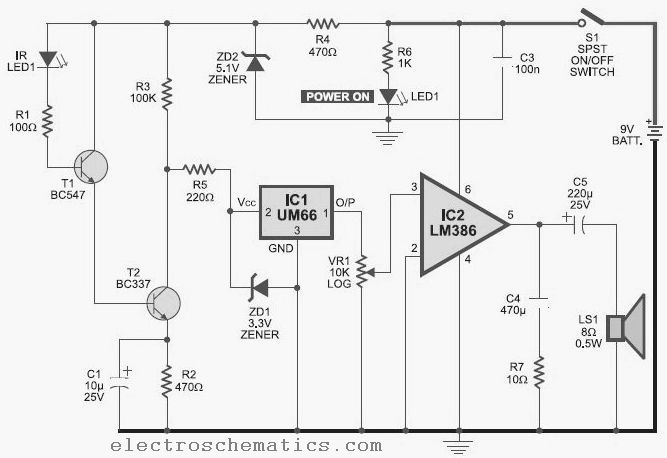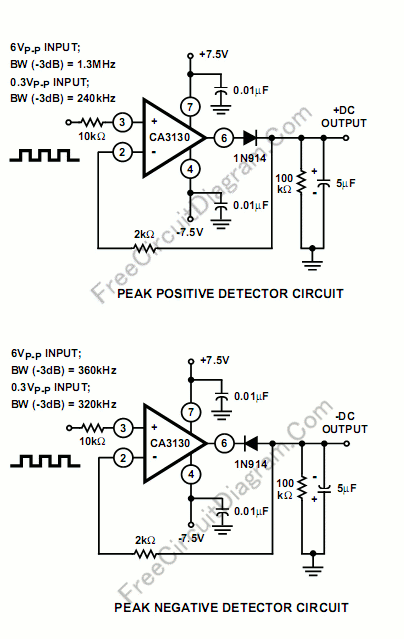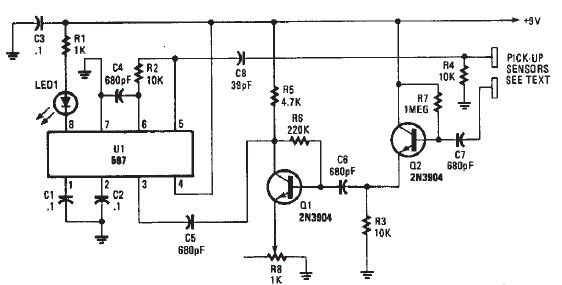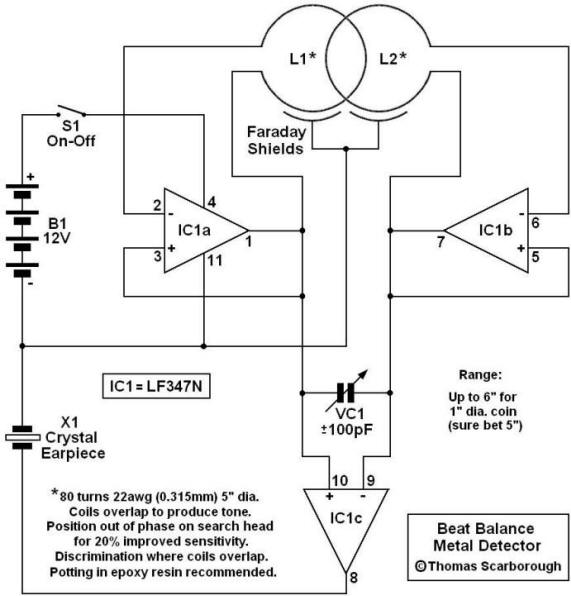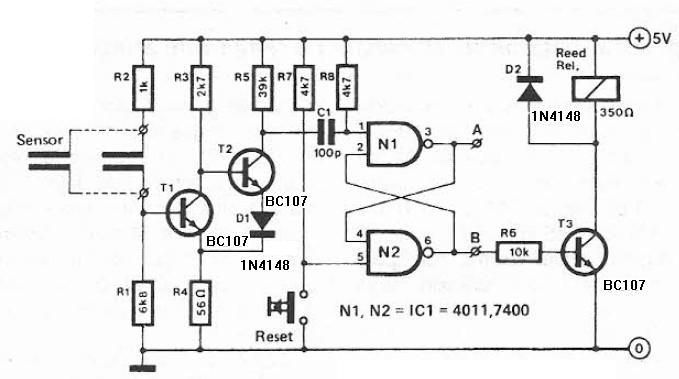
Beat Balance Metal Detector

Various embodiments of the BB metal detector have been published, and it has been widely described in the press as a new genre. Instead of using a search and a reference oscillator as with BFO, or Tx and Rx coils as with IB, it uses two transmitters or search oscillators with IB-style coil overlap. The frequencies of the two oscillators are then mixed in similar fashion to BFO, to produce an audible heterodyne. On the surface of it, this design would seem to represent little more than a twinned BFO metal detector. More: However, what makes it different above all else, and significantly increases its range, is that each coil modifies the frequency of the adjacent oscillator through mutual coupling. This introduces the "balance" that is present in an IB metal detector, and boosts sensitivity well beyond that of BFO. Since the concept borrows from both BFO and IB, I have given a nod to each of these by naming it a Beat Balance Metal Detector, or BB for short. Happy hunting!
The BB metal detector operates on a unique principle that combines elements of both Beat Frequency Oscillator (BFO) and Induction Balance (IB) technologies. It employs two transmitters, or search oscillators, which are strategically placed to overlap with the coils typical in IB designs. This configuration allows for the mixing of the two oscillator frequencies, generating an audible heterodyne signal that can be processed to detect metallic objects.
A key feature of the BB detector is the mutual coupling between the coils and the oscillators. This interaction modifies the frequency of the adjacent oscillator, which enhances the overall sensitivity and range of the detector. The design effectively introduces a balance mechanism akin to that found in IB detectors, allowing for improved performance in various soil conditions and target types.
The circuit typically consists of the following components: two oscillator circuits, each tuned to slightly different frequencies, and a mixing stage that combines the outputs of these oscillators. The mixed signal is then filtered and amplified to produce a clear audio output that indicates the presence of metal. Additionally, the circuit may include adjustable parameters to fine-tune the sensitivity and discrimination capabilities, allowing the user to optimize performance based on environmental conditions and target characteristics.
In summary, the BB metal detector represents an innovative approach to metal detection by leveraging the strengths of both BFO and IB technologies, resulting in a device that offers enhanced sensitivity and range through its unique oscillator and coil configuration.Various embodiments of the BB metal detector have been published, and it has been widely described in the press as a new genre. Instead of using a search and a reference oscillator as with BFO, or Tx and Rx coils as with IB, it uses two transmitters or search oscillators with IB-style coil overlap.
The frequencies of the two oscillators are then mixed in similar fashion to BFO, to produce an audible heterodyne. On the surface of it, this design would seem to represent little more than a twinned BFO metal detector.
However, what makes it different above all else, and significantly increases its range, is that each coil modifies the frequency of the adjacent oscillator through mutual coupling. This introduces the "balance" that is present in an IB metal detector, and boosts sensitivity well beyond that of BFO.
Since the concept borrows from both BFO and IB, I have given a nod to each of these by naming it a Beat Balance Metal Detector, or BB for short. Happy hunting! 🔗 External reference
The BB metal detector operates on a unique principle that combines elements of both Beat Frequency Oscillator (BFO) and Induction Balance (IB) technologies. It employs two transmitters, or search oscillators, which are strategically placed to overlap with the coils typical in IB designs. This configuration allows for the mixing of the two oscillator frequencies, generating an audible heterodyne signal that can be processed to detect metallic objects.
A key feature of the BB detector is the mutual coupling between the coils and the oscillators. This interaction modifies the frequency of the adjacent oscillator, which enhances the overall sensitivity and range of the detector. The design effectively introduces a balance mechanism akin to that found in IB detectors, allowing for improved performance in various soil conditions and target types.
The circuit typically consists of the following components: two oscillator circuits, each tuned to slightly different frequencies, and a mixing stage that combines the outputs of these oscillators. The mixed signal is then filtered and amplified to produce a clear audio output that indicates the presence of metal. Additionally, the circuit may include adjustable parameters to fine-tune the sensitivity and discrimination capabilities, allowing the user to optimize performance based on environmental conditions and target characteristics.
In summary, the BB metal detector represents an innovative approach to metal detection by leveraging the strengths of both BFO and IB technologies, resulting in a device that offers enhanced sensitivity and range through its unique oscillator and coil configuration.Various embodiments of the BB metal detector have been published, and it has been widely described in the press as a new genre. Instead of using a search and a reference oscillator as with BFO, or Tx and Rx coils as with IB, it uses two transmitters or search oscillators with IB-style coil overlap.
The frequencies of the two oscillators are then mixed in similar fashion to BFO, to produce an audible heterodyne. On the surface of it, this design would seem to represent little more than a twinned BFO metal detector.
However, what makes it different above all else, and significantly increases its range, is that each coil modifies the frequency of the adjacent oscillator through mutual coupling. This introduces the "balance" that is present in an IB metal detector, and boosts sensitivity well beyond that of BFO.
Since the concept borrows from both BFO and IB, I have given a nod to each of these by naming it a Beat Balance Metal Detector, or BB for short. Happy hunting! 🔗 External reference
